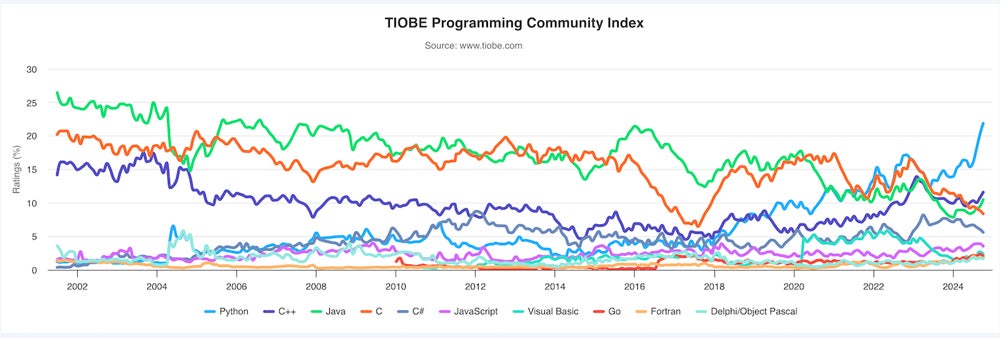The Evolving Landscape of Programming Languages and AI in Development
As technology continues to advance at a breakneck pace, discussions around programming languages and the implications of artificial intelligence (AI) are becoming increasingly relevant. A recent spotlight was cast on these areas when various claims emerged regarding the use of FEMA hurricane relief funds. This narrative intertwines with the ongoing evolution of programming languages like Python and the rapid rise of AI tools such as generative AI models in software development. In this article, we aim to explore these themes, providing clarity on the claims surrounding FEMA funds and insights into the future of programming languages.

Understanding the claims around FEMA funding
The FEMA Funding Claims: Fact and Fiction
Recently, a Facebook post alleged that the Biden administration misappropriated FEMA funds intended for hurricane relief to aid illegal immigrants. This claim echoed through various platforms, amplified by voices including Republican representatives and public figures such as Elon Musk and Donald Trump. However, both FEMA and a White House representative clarified that these assertions are unfounded. The funds in question are legally obligated to be used strictly for disaster-related purposes, not for helping illegal immigrants. Furthermore, FEMA’s emergency food and shelter program exists separately, serving different demographic needs.
In light of these confirmations, it becomes clear that misinformation can easily spread, sometimes even intertwining with genuine concerns in the community. This scenario highlights the importance of maintaining accurate discourse around federal programs and resources intended for crisis management.
The Rise of Rust and Mojo in Programming
Turning our attention to the programming world, the TIOBE Programming Community Index recently revealed notable shifts. Python remains a dominant programming language, jumping from 20.17% to 21.9% popularity. Rust, however, has emerged as a promising contender, climbing to number 13 in the index with increasing usage among developers. It underscores a growing search for programming languages that offer security, speed, and ease of learning, especially in the context of developing secure applications.

Table of programming trends and developments
The allure of Rust lies in its memory safety features and performance—qualities desirable in the modern coding landscape where security vulnerabilities are a pressing concern. Jansen, CEO of TIOBE Software, notes that Rust fits the bill for many developers, making it an increasingly popular choice as the hunt for new programming languages continues. Meanwhile, Mojo, a newcomer created by Chris Lattner, has risen into the top 50 of the index within just a year, showcasing a blend of Python’s simplicity and Swift’s efficiency, raising eyebrows across the programming community.
Generative AI: Tools with Limitations
While programming languages evolve, so do the tools developers rely on. Generative AI, particularly models like GPT-4, have quickly gained favor among programmers. These tools can expedite the coding process but come with their own sets of risks. A significant concern is that reliance on AI can create a misleading sense of security. Developers may trust suggestions for code libraries or package recommendations without conducting due diligence, which could inadvertently introduce vulnerabilities into their projects.
“Generative AI offers astounding benefits, but if a blind eye is turned to due diligence, it can inadvertently introduce security vulnerabilities in your code.”
As new tools become integrated into daily development tasks, the potential for autorecommendations to contain outdated or insecure code increases. Developers are thus encouraged to build robust security practices alongside their use of these innovative tools. Creating a mature DevSecOps program, promoting awareness, and enforcing a stringent code of conduct for AI tools are vital steps forward.
The Future of Programming: Integration of AI and Language Evolution
As both programming languages and AI models continue to develop, the landscape for developers is transforming. Python, while still reigning supreme in ease of use, faces competition from Rust and newcomers like Mojo, which emphasize security and performance. Likewise, the integration of generative AI into the development workflow poses new challenges that require an evolution in secure coding practices.
Such a paradigm shift mandates continuous learning and adaptation. By staying informed, developers can navigate these changes effectively, leveraging new languages and AI tools while safeguarding their projects against potential vulnerabilities. The combination of adaptability and innovation will define the next chapter in programming as developers seek to harness both the power of language efficiency and the capabilities of AI.

Imagining the future of coding
Conclusion
In an environment where misinformation can arise around serious issues like federal funding, clarity becomes paramount. Equally important is the ongoing dialogue surrounding programming languages and AI tools in software development. As we advance, balancing innovative technology’s allure with vigilance in security practices will be crucial for fostering a robust programming ecosystem. The choices made today will impact development practices and the landscape of programming languages for years to come, shaping how we build the future of technology.
For further reading on programming trends and tools, explore the TIOBE Index or discover the new potentials of Rust and Mojo.


 Photo by
Photo by 











